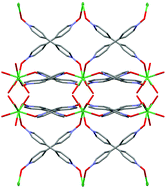Structure and efficient luminescence upconversion of Ln(iii) aromatic N-oxide coordination polymers†
Abstract
A series of lanthanide-based coordination polymers {[Yb1−xErx(4,4′-bpdo)3(H2O)2](CF3SO3)3}∞ were synthesised by solvent diffusion techniques, where 4,4′-bpdo = 4,4′-bipyridine-N,N′-dioxide, and using differing mole fractions of Yb(III) and Er(III) which were systematically varied (x = 0, 0.05, 0.20, 0.50 and 1). All of the materials obtained were characterised using elemental analyses, single-crystal X-ray diffraction (SXRD) and solid-state photoluminescence studies. Structurally, the coordination polymers crystallise as an isomorphous series of infinite 2D sheets, which contain two inner sphere water molecules, and are isostructural with a previously characterised homometallic Yb(III) compound. In addition to the normal Near Infra-Red (NIR) luminescence, these compounds also demonstrate upconversion emission upon 980 nm excitation. Upconversion luminescence measurements reveal visible emission in the red, green, and blue regions corresponding to the 2H11/2 → 4I15/2, 4F9/2 → 4I15/2 and 2H9/2 → 4I15/2 transitions of the Er(III) cation upon two and three-photon excitation. We also observed weak emission from the Er(III) cation in the UV region for the first time in a Ln-MOF based material.


 Please wait while we load your content...
Please wait while we load your content...